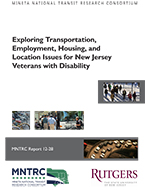Abstract:
Working-age veterans with disability face myriad responsibilities when they seek to rejoin civilian life. They must secure housing and employment while coping with health care concerns and one or more disabilities. Access to transportation – particularly public transportation and paratransit options – is truly a lynchpin that impacts their ability to meet these diverse needs successfully. Too often, however, transportation issues are not adequately considered in veteran reintegration planning. More than 21 million veterans live in the United States, and one-quarter describe themselves as living with a disability, according to the American Community Survey. New evidence suggests that these figures may underrepresent the population affected with disability, particularly regarding veterans of recent military conflicts, including the wars in Iraq and Afghanistan.
This report explores the intersection among transportation, housing, and employment to successful veteran reintegration. The authors gained insight through interviews convened with diverse stakeholders from the U.S. and New Jersey veteran community, as well as from focus group work with veterans with disability. The authors conclude that pursuit of transit-oriented development (TOD) for this population in both suburban and urban locales is an excellent model to consider for further replication throughout the U.S. as one means to help address veteran housing, employment, and other reintegration demands within a context that acknowledges transportation needs and the benefits associated with locational efficiency.
Publications:
Authors:
STEPHANIE DIPETRILLO
Stephanie DiPetrillo is Senior Research Specialist at the Alan M. Voorhees Transportation Center, Rutgers University. She has more than ten years of experience in transportation and urban planning research, as well as in historic preservation, architecture, and urban design. Her current work combines quantitative and qualitative techniques and examines connections between transportation and land use, principally transit, community transportation, and transit-oriented development (TOD). Past works include: Eliminating Barriers to TOD, Economic Development Benefits of New Transit Service: RiverLINE, and The Impact of Demographic Changes in Transit Patterns in New Jersey, all funded by the NJ DOT Research Bureau; and An Evaluation of Property Values in New Jersey Transit Villages funded by the New Jersey Association of Realtors Governmental Research Foundation. She recently completed two projects that examined community transportation and its ability to serve people with disabilities in traveling to work. The first, A Strategy for Getting People with Disabilities to Work: Supporting NJ County Transportation, looked closely at the financial underpinnings of New Jersey’s county transportation providers as well as national best practices for efficient and effective provision of community transportation. The second, Connecting to Jobs by Connecting to Transit, sought to develop, pilot, and refine a transportation orientation program for employment counselors working with people with disabilities. She is the editor of the online publication, NJTOD. org, home to the Transit-Friendly Development Newsletter, sponsored by NJ Transit, and is an advisor to The TOD Line, an online newsletter of TOD in New York and Connecticut. She has taught at Hofstra University, Rutgers University, and the New Jersey Institute of Technology (NJIT). Ms. DiPetrillo holds a BA in Economics and a Master of City and Regional Planning from Rutgers, as well as a Master of Architecture from the NJIT.
ANDREA LUBIN
Andrea Lubin is a senior research specialist at the Alan M. Voorhees Transportation Center (VTC), Rutgers University, with more than ten years of experience in transportation policy analysis, research, and outreach. She is focused on designing and conducting qualitative and quantitative research that often incorporates primary data collection and analysis through consumer surveys, key informant interview sessions, focus groups, and case study analysis. Her research focuses on access to transportation for disadvantaged populations, including people with disabilities and the elderly. Recent examples of her transportation-equity focused projects include two studies funded by the New Jersey Division of Disability Services and Medicaid Infrastructure Grants (MIG). One effort involved co-creating a travel orientation program for vocational rehabilitation professionals to improve employment outcomes for people with disabilities. The second MIG study examined best practices to help county community transportation providers in New Jersey and beyond in meeting the travel needs of the transportation-disadvantaged. In the recent past, under a Federal Transit Administration grant, Ms. Lubin explored the barriers to transportation encountered by job-seeking New Jerseyans with disabilities. She also facilitated the creation and transfer of an online transportation information resource people with disabilities that has since become a component of the New Jersey human services resource NJ 2-1-1. In addition, she has contributed to a diverse body of research at the Voorhees Transportation Center, including customer perceptions of transit security, transit patron needs, and Safe Routes to School initiatives. Ms. Lubin received her undergraduate degree from Tufts University and a Master of Science in public policy from the Eagleton Institute/Bloustein School of Planning and Public Policy at Rutgers University.


